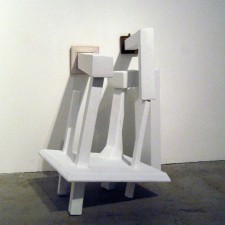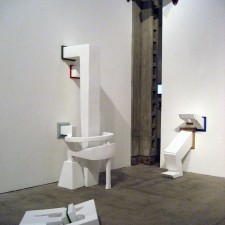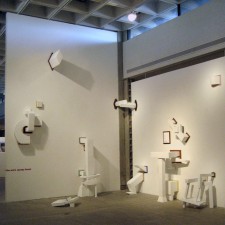Myers, Holly. “Feminist art exhibit measures magic, beauty “Multiple Vantage Points” dynamically captures the feminist spirit,” LA Times, Tuesday March 13, 2007.
Thanks to an impressive display of trans-institutional organizing, feminist fever is sweeping the Southland this season, with female-centered exhibitions and events cropping up all over town. “Multiple Vantage Points: Southern California Women Artists, 1980-2006,” at Los Angeles Municipal Art Gallery, is one of the largest, after “WACK! Art and the Feminist Revolution” at the Museum of Contemporary Art, and essential viewing for anyone inspired by what they see there.
Taking up where “WACK!” leaves off chronologically, “Multiple Vantage Points” narrows the focus to our region, celebrating artists who have continued to carry the mantle, or at least proceeded in its wake, in the context of the Southern California scene.
“Celebrate” is the key word. Unlike “WACK!,” this isn’t a scholarly show; it’s notably light on the politics, and, with 50 artists, it’s predictably unwieldy.
But it’s winningly enthusiastic and stocked with plenty more good art than bad, which may be the most one can ask from a survey with so few parameters. Curated by Dextra Frankel in the time-honored feminist spirit of inclusion (“To those artists not exhibited,” she apologizes in the catalog, “it was truly due to limited space available”), it is a testament to the expanded range of possibilities for female artists in recent decades, allowing for the pursuit of a now virtually limitless variety of media, issues and concerns.
In her catalog essay, Suvan Geer situates the exhibition primarily in the context of postmodernism, identifying threads of reflexivity and social critique, distrust of “universal” truths, and concerns with gender, identity, the body and the gaze. The characterization holds true in many cases, particularly in the works of the 1980s and early ’90s — by Judith Baca, for instance, Catherine Opie, Erika Rothenberg, Sandra Rowe, Alexis Smith and the Saar women (Alison, Betye and Lezley). What’s striking, however, is how limited the interpretation seems, failing to account for many aspects of the older artists’ work — especially more recent examples — and breaking down altogether in relation to the youngest, making it clear that we’ve moved into a different era.
More interesting are the threads that emerge across generational lines. (Frankel breaks down the group into 13 emerging, 24 mid-career and 13 “seasoned” artists.)
One of the most intriguing of these threads is a tendency toward theatricality. The show is filled with costumes. Eleanor Antin stages a debauched Roman feast in a 2001 photograph called “The Last Days of Pompeii”; Rachel Rosenthal rotates between a whole closetful of identities in a lively video montage documenting her theater company.
The subjects in Opie’s mid-1990s portraits appear in drag, face paint, tattoos and other subcultural guises. The paintings of Camille Rose Garcia draw viewers into a fantastical gothic underworld, and Marnie Weber’s “The Spirit Girls, Songs That Never Die,” a 2005 video installation, takes them through a fairy tale realm populated by magical animals and mysterious masked women.
Another notable thread is a poetic sensitivity to the quality of objects. Kim Abeles’ “The Importance of Objects” is the quintessential example: a table-shaped sculpture containing an assortment of anthropological specimens (bones, formaldehyde-soaked insects, a taxidermied bird, a Navajo rug) as well as several embedded video monitors exploring the storage facilities of the Natural History Museum of Los Angeles County.
Lita Albuquerque arranges fragments of honeycomb in pools of golden honey to suggest maps in a beautiful installation called “Terra Incognita.” Sarah Perry fashions a swamp monster from the tissue-thin pages of a Bible, the rings of Saturn from a handful of tiny bones. Tanya Batura draws an eerie sensuality out of painted clay in sculptures such as “Lovers,” a pair of smooth white heads, joined at the crown, with burning red tongues and mouths.
In the sculptures of Carlee Fernandez, among the most intriguing and beautiful works in the show, taxidermied animals turn into other objects: birds into trees, a rabbit into an tangerine branch, a deer into a laundry basket.
These are only a few of the many “vantage points” it’s possible to identify. (I haven’t even mentioned the noteworthy additions of Karen Carson, Carole Caroompas, Liz Larner, Uta Barth, Amy Adler, Enjeong Noh, Patty Wickman, Tamara Sussman, Bari Ziperstein and others.) Indeed, one could argue that there are 50 — one for each artist.
It’s worth asking what such a broad-based approach hopes to achieve at this point in history — and whether it still makes sense to speak of “women’s art” or whether the risk of tokenism isn’t likely to do more harm than good. But this celebratory moment may not be the time.
Then again, judging from the many avenues of dialogue the feminist fever is opening up around town — artists’ talks, lectures, panel discussions, conferences, the already lively discussion board on the “WACK!” website (www.moca.org/wack), maybe it is.


